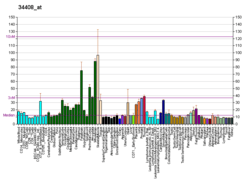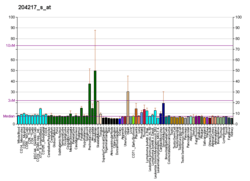References
- 1 2 3 GRCh38: Ensembl release 89: ENSG00000125744 - Ensembl, May 2017
- 1 2 3 GRCm38: Ensembl release 89: ENSMUSG00000030401 - Ensembl, May 2017
- ↑ "Human PubMed Reference:".
- ↑ "Mouse PubMed Reference:".
- ↑ Stubbs L, Carver EA, Shannon ME, Kim J, Geisler J, Generoso EE, Stanford BG, Dunn WC, Mohrenweiser H, Zimmermann W, Watt SM, Ashworth LK (Dec 1996). "Detailed comparative map of human chromosome 19q and related regions of the mouse genome". Genomics. 35 (3): 499–508. doi:10.1006/geno.1996.0390. PMID 8812484.
- ↑ Geisler JG, Stubbs LJ, Wasserman WW, Mucenski ML (May 1998). "Molecular cloning of a novel mouse gene with predominant muscle and neural expression". Mamm Genome. 9 (4): 274–82. doi:10.1007/s003359900748. PMID 9530622.
- 1 2 "Entrez Gene: RTN2 reticulon 2".
Further reading
- Ballif BA, Villén J, Beausoleil SA, et al. (2005). "Phosphoproteomic analysis of the developing mouse brain". Mol. Cell. Proteomics. 3 (11): 1093–101. doi:10.1074/mcp.M400085-MCP200. PMID 15345747.
- He W, Lu Y, Qahwash I, et al. (2004). "Reticulon family members modulate BACE1 activity and amyloid-beta peptide generation". Nat. Med. 10 (9): 959–65. doi:10.1038/nm1088. PMID 15286784.
- Reuter TY, Medhurst AL, Waisfisz Q, et al. (2003). "Yeast two-hybrid screens imply involvement of Fanconi anemia proteins in transcription regulation, cell signaling, oxidative metabolism, and cellular transport". Exp. Cell Res. 289 (2): 211–21. doi:10.1016/S0014-4827(03)00261-1. PMID 14499622.
- Oertle T, Klinger M, Stuermer CA, Schwab ME (2003). "A reticular rhapsody: phylogenic evolution and nomenclature of the RTN/Nogo gene family". FASEB J. 17 (10): 1238–47. doi:10.1096/fj.02-1166hyp. PMID 12832288.
- Strausberg RL, Feingold EA, Grouse LH, et al. (2003). "Generation and initial analysis of more than 15,000 full-length human and mouse cDNA sequences". Proc. Natl. Acad. Sci. U.S.A. 99 (26): 16899–903. doi:10.1073/pnas.242603899. PMC 139241. PMID 12477932.
- Geisler JG, Palmer RJ, Stubbs LJ, Mucenski ML (2000). "Nspl1, a new Z-band-associated protein". J. Muscle Res. Cell. Motil. 20 (7): 661–8. doi:10.1023/A:1005533013926. PMID 10672514.
- Roebroek AJ, Contreras B, Pauli IG, Van de Ven WJ (1998). "cDNA cloning, genomic organization, and expression of the human RTN2 gene, a member of a gene family encoding reticulons". Genomics. 51 (1): 98–106. doi:10.1006/geno.1997.5175. PMID 9693037.





